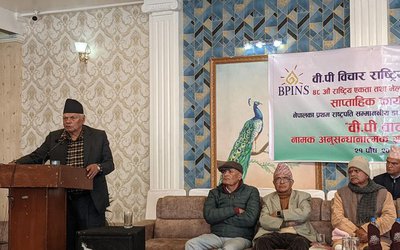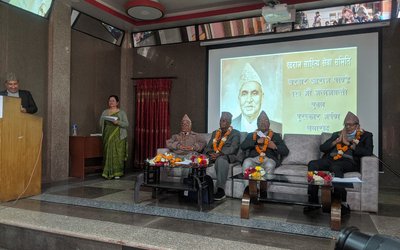Happiness is a subjective mental state, and so differs from person to person. It has different grades of expressions, but very broadly speaking happiness can be divided into human/personal happiness and impersonal happiness or Sat-Chit-Ananda. Generally, human happiness depends on conditions being perceived as positive, but then it is temporary, unstable and personal. It is not yet established inner peace or Bliss or Sat-Chit-Ananda or the ultimate combination of Existence-Knowledge-Bliss, also called the transcendental happiness. It has to be gained as well as to be received through our efforts from below and the grace from above or combination of both. Although some schools of thought lay stress solely on our personal efforts or on the capability of our mind to the exclusion of other alternative ways of realization, the more probable and even more practical approach seems to be that we must go with the intellect as far as it can lead, but leave it behind when it leads to a dead end by finding the better way of achieving the set objective i.e. Sat-Chit-Ananda which is a state beyond the human happiness.
Sometimes, pleasure is equated with happiness although they do not mean the same thing. At best, pleasure could be understood as a precursor to happiness. It requires sensory stimulation and is primarily of physical origin. Pleasure is then satisfaction of one’s desires which change from moment to moment. It is often likened with changeable weather. Happiness is a stage above that of pleasure as happiness cannot be attained without our conscious effort. Equating pleasure with happiness is a serious psychological mistake. The mistake can be corrected by developing will power, intuition and self-awareness which together show that the source of happiness is within and not outside, but a positive mental attitude is the most important condition for being happy. Pleasure, on the other hand, always has its source outside, and is nourished by outside stimuli. It is then more a passive mental reaction to these stimuli, but happiness is something we have to create inside us, and this begins with the positive attitude of the mind. It is also with this positive attitude that we open ourselves to what is above the logical mind. This is the first step of our spiritual journey and begins when we learn the art of being happy, but we don’t get happiness as easily as we get pleasure which is temporary and diminishes with time as well as with overstimulation/excitement. Pleasure and pain are, therefore, never unmixed, because we always get trapped in the cycle of duality (seeking pleasure and avoiding pain). In fact, this duality is the very basic feature of the ego which we normally are. Happiness, on the other hand, does not depend on excitement and outer stimuli. It is expanding ourselves inwardly through the act of living into life consciously. Doing things consciously is the first prerequisite of the act of being happy. In fact, it is the beginning of all spiritual endeavors. Achieving durable happiness is a skill. It requires sustained effort in training the mind and developing a set of human quality such as inner peace, mindfulness, and altruistic love, -Richard Matthieu.
Happiness emanates from within and radiates in all directions as its source is within us. A mind in peace with itself is what makes our life happy, and constitutes the starting point of our inward journey. Happiness finds its best expression when we not only wish happiness for others but actually work for others’ happiness. In one or another time, some of us must have done something that really helped others in time of their distress. The mental peace that results from such actions can be associated with what we call human happiness, but this happiness grades into Bliss or Sat-Chit-Ananda when happiness is sustained by constant inner peace. So there is some difference between human happiness and real happiness or Sat-Chit-Ananda. While human happiness still contains a psychological element, the real peace arises from within. While human happiness does not come automatically, and has to be gained through strenuous efforts, the real peace has to be rediscovered. The most important characteristic features of the real peace can be summarized as follows:
The essential point is that happiness is determined more by one’s state of mind (or level of mind my addition) than by external events … Whether we are feeling happy or unhappy has very little to do with our absolute conditions, but rather it is a function of how we perceive our situation, how satisfied we are with what we have, -The Dalia Lama
The primary cause of unhappiness is never the situation but thought about it. Be aware of the thoughts you are thinking. Separate them from the situation which is always neutral. It is as it is, Eckhart Tolle.
“Happiness is rejoicing in the truth”- Saint Augustine.
Ultimate Happiness – a kind of happiness that is stable and persistent. A state of happiness that remains despite life’s ups and downs and normal fluctuations of mood as part of the very matrix of our being - The Dalai Lama
Anyone who enjoys inner peace is no more broken by failure than he is inflated by success. He is able to fully live his experience in the context of a vast and profound serenity, since he understands that experiences are ephemeral and that it is useless to cling to them - Matthieu Ricard.
The basic characteristics of happiness, as expressed in all these quotations are almost the same. The implied happiness is often considered to be the lasting happiness which is not within the reach of most of us. In fact, it is very few people who can say “I am happy”. But those who expressed happiness in these terms must have experienced happiness as it is, and these must be the people who have worked very hard perhaps all through their lives. Since happiness is first registered through mind and since it is the state of mind that determines how we cultivate happiness, the most important pre-requisite for the cultivation of happiness is to train the mind. Buddhism puts the greatest importance on the art of mental training for achieving happiness. Therefore, the mind must firstly be made calm or peaceful internally. Quoting the Dalai Lama: As long as there is a lack of the inner discipline that brings calmness of mind, no matter what external facilities or conditions you have, they will never give you the feeling of joy and happiness that you are seeking. On the other hand, if you possess this inner quality, a calmness of mind, a degree of stability within, then even if you lack various external facilities that you would normally consider necessary for happiness, it is still possible to live a happy and joyful life.
Happiness is registered through our mind, but its first registration may not directly be associated with the real happiness, although it may serve as precursor of that happiness. There is, however, the probability that we take these precursors as real happiness, but a discerning judgment based on the basic characteristic features of happiness outlined above can easily reveal the underlying fallacy, Matthieu, Ricard: Happiness can’t be limited to a few pleasant sensations, to some intense pleasure, to an eruption of joy or a fleeting sense of serenity, to a cheery day or a magic moment that sneaks up on us in the labyrinth of our existence. Such diverse facets are not enough in themselves to build an accurate image of the profound and lasting fulfillment that characterizes true happiness.
In the light of the above statements, it is important to differentiate between happiness and some of the precursors that may give us the false impression of happiness. Perhaps the most obvious precursor is pleasure, which we often mistakenly take for happiness. A little introspection is enough to reveal the underlying fallacy. The origin of pleasure lies in outer stimuli such as sensual, esthetic or intellectual stimuli whose nature is material. First the experience is momentary/fleeting and circumstantial. For example, the pleasure one obtains eating a certain food depends, among others things, on how hungry the person is. Even the outer look of food may be enticing or otherwise. Once he/she is full, the pleasure associated with eating a delicious food may all be gone. Further, eating too much of the same food is likely to create distaste. While an experience of happiness is cumulatively positive, repeated experience of certain type of pleasure may even be cumulatively negative.
Happiness is cumulative in the sense that its realization depends on how well we are able to train the mind and connect us with the Higher Self. So there are grades of happiness. For example, the quality and intensity of happiness we gain through altruistic deeds when we wish to freely serve others will be enhanced if we act out of compassion. The effort one has to put into training his mind to the level of a compassionate mind would, however, be disproportionately high, but not impossible to make, but one has to take recourse to various Yogic methods of mind control through psychological and spiritual transformation of mind. The objective here is to transcend intellectual satisfaction which represents human happiness to real happiness through intellectual illumination which is the immediate condition of salvation.
Our spiritual journey depends on our conscious upward progression of our consciousness whose nature is to rise to ever higher and higher levels of consciousness that may finally culminate in Bliss. Bliss is not, however, something we have to attain through our mental efforts as is the case with happiness. We have to keep on trying for happiness which also means trying for Bliss. Bliss is eternal; it is just there for us to just realize it, but Bliss is qualitatively different from human happiness. The human happiness for which we have to struggle is not simply elevated to Bliss; it has to undergo a complete and qualitative metamorphosis in order to be transformed into Bliss. While Bliss is beyond all mental constraints, the latter still requires mental support for its continuance. Therefore, the transformation from happiness to Bliss is qualitative not just quantitative.
Happiness too is a form of energy. Therefore, the quality of the experience of happiness depends on the level or quality of this energy, which is initially mental energy. We are happier when we are more energetic. At its lowest level this energy is matter-bound and at its highest level it is all-encompassing creative energy i.e. Bliss, which is neither mental nor emotional. Emotions do not originate from our inner essence. They represent amplified or energized thought patterns and usually overpower us because it is an unconscious faculty. On the other hand, love, joy and peace are deep and undualistic states of Truth. The associated energy is positive and can be used for our spiritual progress.
The concept of energy into which matter can be converted is now a well known fact as evidenced also by the theory of quantum mechanics which has shown that matter and energy are the two forms of expression of the same substance which in the East is called Sat-Chit-Ananda, and which represents both the nirakaara as vibrating energy or bliss or Consciousness as well as the saakara/condensed form of energy or matter. Quantum mechanics has raised some very important questions about our existence. It has shown the convertibility of matter and energy i.e. matter and energy are the two forms of expression of the same substance, although it does not tell what this same substance is. One can also talk about their unity, but the problem with most of the quantum physicists is that they can observe only the most external manifestations of the rationalistic mind. However, we have to remember that while energy can be a form of matter, it is not the creation of matter. The creator is an unattached observer. Quantum physicists also say that matter is not the final solid block of substance and that it vibrates in many different degrees of energy the densest form of which is matter itself. The subtlest form of our existence is then pure energy irrespective of whether it was previously dormant in a tree, a stone or water or its vapor as all these are ultimately composed of the same substance. The Vedic literature also supports the concept of the primordial energy constituting the building block of the ultimate existence, - Sat-Chit-Aanada.
Pleasure feeds on sensory stimulation, it can excite our mind and so is self-indulgence. Happiness, on the other hand, brings inner peace which is the most important pre-requisite for any inward journey. If we accept that happiness is related to an internal organ, is self-generated and depends on nothing external to itself, then we naturally open our mind and heart to Bliss. Happiness is then self-generated, self-supporting, and represents various stages on the way to the divine Bliss. We may feel happiness even when the outer conditions are perceived as something good and positive, but there is a qualitative difference between feeling good and being the good itself. Feeling something is different from comprehending it intellectually, but the joy of feeling is much deeper than intellectual comprehension of that something. Feelings may deceive us but the joy of feeling does not. Feelings and happiness often go together, and like happiness feelings too represent various stages on the way to the divine Bliss, but here one has to be aware of the trappings of pleasures and feelings. But since the transformation from happiness to Bliss is not simple, happiness has to be ignited or as Swami Kriyananda says “the engine of human consciousness needs sparkling so that it can function as super consciousness.”. Happiness is best ignited when we add to it devotion and faith, and open our heart to receive the Bliss also called Pure Consciousness. The happiness is then “experienced within” with no trace of the outer “when the human capacity is stretched to its limit, a spark of understanding and intelligence flashes out and illuminates the subject at issue – Karen Armstrong.

Prof. Dr. Akal Bahadur Singh
Prof. Dr. Singh was one of the founding Pragya in the old pre-1990 RONAST. Recently he has been spending much of his time thinking about the relationship between science and spirituality.
- Sensations, Perceptions And Concentrations
- May 02, 2024
- Insights And Inspirations
- Oct 01, 2023
- Reason, Understanding And Knowledge
- Jul 25, 2023
- Ideas, Actions And Experiences
- Sep 07, 2022
- Unity In Diversity
- Aug 16, 2022
















